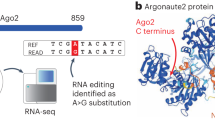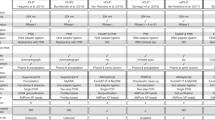Abstract
High-throughput sequencing has opened numerous possibilities for the identification of regulatory RNA-binding events. Cross-linking and immunoprecipitation of Argonaute proteins can pinpoint a microRNA (miRNA) target site within tens of bases but leaves the identity of the miRNA unresolved. A flexible computational framework, microMUMMIE, integrates sequence with cross-linking features and reliably identifies the miRNA family involved in each binding event. It considerably outperforms sequence-only approaches and quantifies the prevalence of noncanonical binding modes.
This is a preview of subscription content, access via your institution
Access options
Subscribe to this journal
Receive 12 print issues and online access
$259.00 per year
only $21.58 per issue
Buy this article
- Purchase on Springer Link
- Instant access to full article PDF
Prices may be subject to local taxes which are calculated during checkout


Similar content being viewed by others
References
Jiang, Q. et al. Nucleic Acids Res. 37, D98–D104 (2009).
Hendrickson, D.G., Hogan, D.J., Herschlag, D., Ferrell, J.E. & Brown, P.O. PLoS ONE 3, e2126 (2008).
Chi, S.W., Zang, J.B., Mele, A. & Darnell, R.B. Nature 460, 479–486 (2009).
Hafner, M. et al. Cell 141, 129–141 (2010).
Sugimoto, Y. et al. Genome Biol. 13, R67 (2012).
Corcoran, D.L. et al. Genome Biol. 12, R79 (2011).
Bartel, D.P. Cell 136, 215–233 (2009).
Baltz, A.G. et al. Mol. Cell 46, 674–690 (2012).
Juang, B.H. & Rabiner, L.R. Technometrics 33, 251–272 (1991).
Friedman, R.C., Farh, K.K.-H., Burge, C.B. & Bartel, D.P. Genome Res. 19, 92–105 (2009).
Khorshid, M., Hausser, J., Zavolan, M. & van Nimwegen, E. Nat. Methods 10, 253–255 (2013).
Skalsky, R.L. et al. PLoS Pathog. 8, e1002484 (2012).
Kishore, S. et al. Nat. Methods 8, 559–564 (2011).
Chi, S.W., Hannon, G.J. & Darnell, R.B. Nat. Struct. Mol. Biol. 19, 321–327 (2012).
Shin, C. et al. Mol. Cell 38, 789–802 (2010).
Brennecke, J., Stark, A., Russell, R.B. & Cohen, S.M. PLoS Biol. 3, e85 (2005).
Leung, A.K. et al. Nat. Struct. Mol. Biol. 18, 237–244 (2011).
Betel, D., Koppal, A., Agius, P., Sander, C. & Leslie, C. Genome Biol. 11, R90 (2010).
Siepel, A. et al. Genome Res. 15, 1034–1050 (2005).
Feederle, R. et al. J. Virol. 85, 9801–9810 (2011).
Flicek, P. et al. Nucleic Acids Res. 38 (suppl. 1), D557–D562 (2010).
Li, B. & Dewey, C.N. BMC Bioinformatics 12, 323 (2011).
Leng, N. et al. Bioinformatics 29, 1035–1043 (2013).
Majoros, W.H. Methods for Computational Gene Prediction (Cambridge Univ. Press, 2007).
Fariselli, P., Martelli, P.L. & Casadio, R. BMC Bioinformatics 6 (suppl. 4), S12 (2005).
Lekprasert, P., Mayhew, M. & Ohler, U. PLoS ONE 6, e20622 (2011).
Acknowledgements
This work was supported by grants from the US National Science Foundation (MCB-0822033) and US National Institutes of Health (NIH R01-GM104962) to U.O. and by awards from the NIH (R01-AI067968; R01-DA030086) to B.R.C. Contributions by R.L.S. were additionally supported by a Duke Center for AIDS Research small grant award (P30-AI064518). We thank S. Grosswendt and M. Piechotta for critical reading of a manuscript draft.
Author information
Authors and Affiliations
Contributions
W.H.M. implemented the modeling framework and designed the models, P.L. and W.H.M. performed the computational experiments, P.L. investigated bulge sites, and N.M. and D.L.C. configured and ran the PARalyzer pipeline and provided guidance on analyzing its outputs. P.L., W.H.M. and U.O. analyzed the data. R.L.S., B.R.C. and N.M. designed and performed wet-lab experiments, and W.H.M., P.L. and U.O. wrote the manuscript.
Corresponding author
Ethics declarations
Competing interests
The authors declare no competing financial interests.
Supplementary information
Supplementary Text and Figures
Supplementary Figures 1–13 and Supplementary Tables 1–4 (PDF 2192 kb)
Rights and permissions
About this article
Cite this article
Majoros, W., Lekprasert, P., Mukherjee, N. et al. MicroRNA target site identification by integrating sequence and binding information. Nat Methods 10, 630–633 (2013). https://doi.org/10.1038/nmeth.2489
Received:
Accepted:
Published:
Issue Date:
DOI: https://doi.org/10.1038/nmeth.2489
This article is cited by
-
MiRNA fine tuning for crop improvement: using advance computational models and biotechnological tools
Molecular Biology Reports (2022)
-
Comprehensive machine-learning-based analysis of microRNA–target interactions reveals variable transferability of interaction rules across species
BMC Bioinformatics (2021)
-
Global identification of functional microRNA-mRNA interactions in Drosophila
Nature Communications (2019)
-
Predicting microRNA targeting efficacy in Drosophila
Genome Biology (2018)
-
microCLIP super learning framework uncovers functional transcriptome-wide miRNA interactions
Nature Communications (2018)



